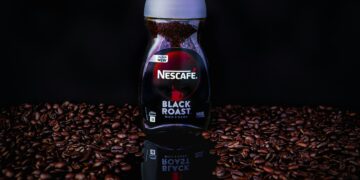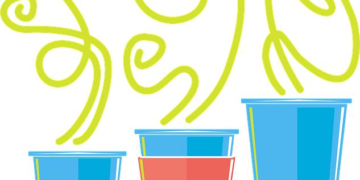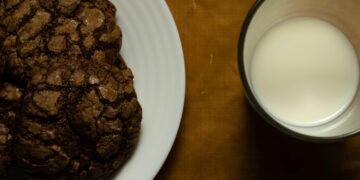Table of Contents
The Sound of Silence in My Mug
I remember the exact moment I almost gave up on “good” coffee.
I was standing in my kitchen, the morning light hitting a beautiful, minimalist bag of single-origin Ethiopian coffee.
It had cost me a small fortune at a roaster whose name was whispered with reverence in online forums.
The label promised a symphony of flavors: jasmine, bergamot, raspberry jam.
I had followed the brewing instructions with the precision of a chemist—weighing the beans, timing the pour, using filtered water at the perfect temperature.
I lifted the mug, inhaled deeply, and took a sip.
Silence.
There was no jasmine, no bergamot, and certainly no raspberry jam.
There was just a thin, disappointingly sour liquid that tasted vaguely of… well, coffee.
This wasn’t the first time.
For years, I had been on this frustrating quest.
I’d buy beans from celebrated roasters in New York, Los Angeles, and Chicago, chasing the exotic tasting notes on the bags like they were clues to a secret society I couldn’t join.1
Each time, the result was the same: a cup that was flat, uninspiring, or just plain confusing.
I felt like a fraud.
Was my palate broken? Was I missing some crucial gene that allowed others to taste the rainbow in their morning cup? The world of specialty coffee, with its esoteric language of “anaerobic maceration,” “honey processing,” and “Gesha varietals,” felt like an exclusive club, and I was stuck outside, peering through the window.1
The problem, as many aspiring coffee enthusiasts discover, is that the coffee world often speaks a language that feels intentionally opaque.
It presents a collection of disconnected facts—origin, altitude, processing, roast level—and expects you to assemble them into a coherent, delicious experience.
It’s a recipe for failure, leaving you feeling lost and unable to make a confident choice.
I was ready to retreat to the familiar, predictable comfort of a dark roast from the supermarket.
And then, one day, it clicked.
The epiphany didn’t come from a coffee textbook or a barista’s lecture.
It came from my old passion: Music. I realized I was thinking about coffee all wrong.
I was trying to memorize a list of parts, when I should have been learning to listen to the whole song.
Part I: The Epiphany — Coffee Isn’t a Commodity, It’s a Composition
My breakthrough was this: a bag of coffee beans is not a static product.
It is a finished musical recording.
This single idea changed everything.
It provided a framework, a mental model that transformed the intimidating jargon of coffee into a story I could understand.
The world of coffee is staggeringly complex; scientific analyses show that coffee has somewhere between 500 and 1,200 volatile flavor compounds, dwarfing the 200 or so found in wine.4
No wonder a simple list of facts is insufficient.
You need a way to organize the information, and the music analogy became my Rosetta Stone, a concept that has been echoed by roasters and musicians alike who see the deep parallels between the two crafts.7
Here’s how the paradigm works:
- The Composer (The Farmer): The coffee farmer is the songwriter. They work with the fundamental elements of the music: the bean’s genetics (the varietal, which is like the song’s key signature) and its environment (the terroir—soil, climate, altitude—which writes the core melody and harmony).
- The Arrangement (The Processing Method): After the coffee cherry is picked, the processing method (how the bean is removed from the fruit) determines the genre and instrumentation of the song. Is it a clean, acoustic track or a heavily distorted rock anthem? This is the arrangement.
- The Producer (The Roaster): The roaster is the studio producer. They take the raw “tracks” from the farm and “mix and master” them through the roasting process. They decide which elements to emphasize, whether to bring the bright, treble notes forward or to boost the deep, bassy tones.
- The Listener & The Stereo (You & Your Brewer): You, the home brewer, are the listener. Your brewing equipment—be it a pour-over dripper, an espresso machine, or a French press—is the stereo system. The same recording can sound vastly different on a pair of cheap earbuds versus a high-fidelity sound system. Your technique is how you tune the dials.
This paradigm shift reframed my entire goal.
I was no longer just trying to “buy coffee beans near me.” I was becoming a music curator, a DJ for my own daily ritual.
My mission was to learn how to read the liner notes on the album cover (the coffee bag) so I could identify the composers, arrangers, and producers I loved.
I was learning to curate my own perfect coffee playlist.
This guide is built on that framework, designed to empower you to do the same.
Part II: The Composer and The Score (Understanding Origin & Processing)
Every great song starts with a core idea, a melody born from a specific time and place.
In coffee, that place is the farm.
The “composer”—the farmer—works with two fundamental elements that are written into the bean long before it ever sees a roaster: its terroir and its processing method.
Understanding these is like learning to distinguish between the styles of Bob Dylan and Bach; it’s the foundational layer of your coffee education.
Subsection 2.1: The Composer’s Studio (Terroir & Varietal)
The “terroir”—a term borrowed from the wine world—encompasses all the environmental factors that give a coffee its unique voice.
It’s the soul of the coffee, its inherent musical D.A.10
- Origin as Melody & Harmony: The country, region, and specific farm where a coffee is grown dictate its fundamental flavor profile.13 Just as different music scenes produce distinct sounds, different coffee-growing regions produce characteristic notes.
- East Africa (Ethiopia, Kenya): Often considered the birthplace of coffee, these regions produce beans with bright, complex, “high-treble” melodies. Think vibrant floral notes like jasmine, crisp citrus, and the wine-like complexity of berries.13
- South America (Colombia, Brazil): These are the masters of harmony and rhythm. Brazilian coffees are known for their deep, foundational bass notes of chocolate and nuts, making them the backbone of many espresso blends. Colombian coffees are prized for their balance and smooth, caramel-like sweetness.13
- Central America (Guatemala, Costa Rica): These coffees are the versatile singer-songwriters, known for their clean, well-rounded profiles that balance sweetness with a pleasant, crisp acidity—often with notes of spice or milk chocolate.13
- Asia-Pacific (Indonesia, Papua New Guinea): This region produces bold, unconventional music. Sumatran coffees, in particular, are famous for their heavy, earthy, and herbal basslines, a “wild card” flavor that can be polarizing but is beloved by those who appreciate its unique character.13
- Altitude as Pitch: Within these regions, altitude plays a critical role. Coffee grown at higher elevations (above 1,500 meters or about 5,000 feet) matures more slowly in the cooler air. This slow development allows more complex sugars and acids to form within the bean, resulting in a denser, more flavorful coffee.13 Think of it as the pitch of the music: higher altitude generally means a higher-pitched, more vibrant, and more aromatic flavor profile.3 Lower altitude coffees tend to have a simpler, earthier, “lower-pitched” character.
- Varietal as the Song’s Key: The specific variety of the coffee plant (e.g., Gesha, Bourbon, Typica, Caturra) is like the song’s musical key. It’s the genetic blueprint that defines the potential range of flavors and characteristics.13 Just as the key of C major has a different feel from A minor, a Gesha varietal has a different inherent potential—often intensely floral and tea-like—than a Bourbon varietal, which is known for its sweetness and balance.16 For a beginner, this is a more advanced detail, but seeing a specific varietal listed on a bag is a strong sign of a high-quality, traceable coffee.
Subsection 2.2: The Arrangement (The Power of Processing)
If terroir is the song, then processing is the arrangement.
This is the step where the farmer decides what “genre” the coffee will be.
After the coffee cherries are picked, the beans (which are the seeds inside) must be removed from the fruit and dried.
The method used to do this is arguably the single most powerful factor in shaping the coffee’s final taste.2
A coffee’s processing method will tell you more about its fundamental character than its country of origin.
A natural-processed coffee from Ethiopia will often have more in common with a natural from Costa Rica than it will with a washed coffee grown on a neighboring Ethiopian farm.
Understanding this is your first major leap toward becoming a confident buyer.
Here are the three main “musical arrangements” you’ll see on a coffee bag:
- Washed (or Wet) Process — The “Acoustic Unplugged” Version: In this method, the fruit pulp and sticky mucilage are completely washed off the bean with water before it’s dried.20 This process is like an acoustic recording session. It strips away all the external layers to reveal the pure, clean, and unadulterated “voice” of the bean itself. Washed coffees are known for their clarity, consistency, and bright, crisp acidity. This method lets the nuances of the terroir and varietal shine through without interference.2 If you want to taste the origin, choose a washed coffee.
- Natural (or Dry) Process — The “Distorted Electric Guitar” Version: This is the oldest processing method. The entire coffee cherry is laid out to dry in the sun with the bean still inside.2 During this extended contact, the bean ferments and absorbs sugars and flavor compounds from the drying fruit. The result is a coffee with intense, often wild and “funky” fruit flavors, a heavy body, and lower acidity.13 This is like running a clean guitar signal through a distortion pedal—it’s bold, powerful, and can be divisive. Some people find natural-processed coffees overwhelmingly fruity, while others (like me) adore their complex, wine-like character.20 If you see notes like “strawberry jam,” “blueberry,” or “tropical fruits,” you’re likely looking at a natural.
- Honey Process — The “Studio Reverb & Sweetening” Version: This method is a hybrid of the first two. The skin of the cherry is removed, but a controlled amount of the sticky, honey-like mucilage is left on the bean as it dries.21 This is the producer adding a touch of reverb and sweetness in the studio mix. It creates a coffee that bridges the gap between the other two methods, offering a beautiful, syrupy body and enhanced sweetness while retaining some of the bean’s original clarity.13 You may see different “colors” of honey processing (yellow, red, black), which refer to how much mucilage was left on the bean—black honey has the most, resulting in the richest, funkiest taste, while yellow honey has the least, yielding a milder, fruitier cup.2
- Experimental Processes — The “Avant-Garde Electronic” Version: You might also encounter terms like “Anaerobic Fermentation” or “Carbonic Maceration”.2 Think of these as the experimental, boundary-pushing genres of coffee. Producers place the coffee cherries in sealed, oxygen-free tanks to create unique and often intense flavors, frequently described as wine-like, spicy, or reminiscent of cinnamon. These are for the adventurous listener.
Part III: The Producer in the Studio (The Roaster’s Critical Role)
Once the “raw tracks” leave the farm, they arrive at the “recording studio”—the roastery.
Here, the “producer” (the roaster) takes the green, unroasted coffee beans and, through the alchemy of heat, transforms them into the aromatic, brown beans we recognize.
The roaster’s job is a delicate balancing act: they must honor the farmer’s original composition while also imparting their own signature style.
This is done through two key decisions: the roast level and the release date.
Subsection 3.1: The Art of the Mix (Roast Levels)
The roast level is the roaster’s “mix.” It determines which frequencies are boosted and which are cut.
Roasting is a chemical transformation where heat breaks down sugars and acids, creating hundreds of new aromatic compounds.6
The roaster’s primary choice is how long to apply that heat, which is measured by key events called “cracks”—audible pops the beans make as moisture and gases escape.
- Light Roast — The “Indie Folk” Mix: A light roast is stopped shortly after the “first crack.” This approach is all about preservation and clarity.13 The roaster’s goal is to develop the coffee just enough to make it soluble and sweet, while preserving as much of the bean’s original, delicate character as possible. This mix keeps the “vocals and acoustic guitar” (the origin flavors) right at the front. Expect bright, sharp acidity, a lighter body, and vibrant floral or fruity notes.1 This is the preferred roast level for most high-end, single-origin specialty coffees.
- Medium Roast — The “Pop/Rock” Mix: Roasted a bit longer, somewhere between the first and second crack, a medium roast is the versatile, crowd-pleasing mix.13 It begins to mute some of the sharp acidity and delicate origin notes in favor of developing more sweetness, body, and balanced, rounded flavors like caramel and chocolate.23 It’s a great starting point for beginners and works well with a wide variety of “stereo systems” (brew methods).
- Dark Roast — The “Heavy Metal” Mix: A dark roast is taken well into or even past the “second crack.” Here, the producer has made a conscious decision to turn the “bass and drums” all the way up. The dominant flavors are no longer from the origin but from the roast itself: smoky, bittersweet, spicy, and intensely chocolatey.13 The original acidity is almost entirely gone, and the beans will often have an oily sheen on their surface as the internal oils have been forced out by the prolonged heat.24 This is a bold, intense style that stands up well to milk and sugar.
Subsection 3.2: The Mastering Date (The “Roasted On” Date is Everything)
This is the single most important piece of information on a coffee bag.
It is the difference between hearing a crisp, clear digital master and a dusty, warped vinyl record found in a damp basement.
If you learn nothing else from this guide, learn this: always look for a “Roasted On” date. Avoid bags that only have a “Best By” or expiration date, as this can be up to 18-24 months after the coffee was actually roasted, by which time it will be hopelessly stale.1
However, the concept of freshness is more nuanced than simply “fresher is better.” This brings us to the freshness vs. resting paradox.
When coffee is roasted, a significant amount of carbon dioxide (CO2) gets trapped inside the beans.26
For the first few days after roasting, this gas is aggressively escaping in a process called “degassing.” If you try to brew coffee during this period, the escaping gas will interfere with the water’s ability to properly extract flavor, leading to a cup that is uneven, sour, and disappointing.26
The coffee needs time to rest and “calm down” before it’s ready to perform at its peak.
Here is a practical guide to this crucial waiting period:
- The Golden Rule: Aim to buy coffee that was roasted within the last two to four weeks.13 This gives it time to rest but ensures you’re consuming it during its peak flavor window.
- The Resting Timeline: The ideal resting period depends on the roast level and your intended brew method.
- Dark Roasts: These beans are more porous and degas faster. They are often ready to brew just 2 to 5 days after roasting.2
- Medium Roasts & Drip/Pour-Over: A good starting point is 3 to 7 days off roast.26
- Light Roasts & Espresso: These denser beans release gas more slowly and are subjected to intense pressure during brewing. They often require a longer rest, sometimes 7 to 14 days or even more, to taste their best and avoid sourness.2
- Proof of Freshness: The Bloom: You can see this degassing process in action. When you pour hot water over freshly roasted, ground coffee, it will bubble and foam vigorously. This is called the “bloom,” and it’s the CO2 escaping.24 If your coffee doesn’t bloom, it’s a sure sign that it’s stale and has lost most of its volatile aromatic compounds.31
Part IV: Reading the Album’s Liner Notes (How to Decode a Coffee Bag)
Now that you understand the “music,” it’s time to learn how to read the “album cover.” A good specialty coffee bag is packed with information—these are the liner notes that tell you the story of the coffee inside.
Learning to decode this information is your key to making informed, confident purchases.
Let’s walk through the essential elements you should look for, from most to least critical.
Here is your checklist for reading a coffee bag like a pro 3:
- Roast Date: This is the album’s release date. It is non-negotiable. If you can’t find a specific “Roasted On” date, put the bag down and walk away.17 This is your number one indicator of quality and care from the roaster.
- Origin (Country, Region, Farm/Estate): This tells you who the “composer” is and where they’re from. Look for specificity. “Colombian Coffee” is vague. “Colombia, Huila, Finca El Mirador” is specific. The more detailed the origin information, the more traceable the coffee, which is a hallmark of high quality and ethical sourcing.3 Be wary of meaningless marketing terms like “mountain-grown” or “100% Coffee”.13
- Processing Method: This is the “musical arrangement” and your best clue to the coffee’s overall style. Does it say Washed, Natural, or Honey? This single piece of information will tell you whether to expect a clean and bright cup, a fruity and wild one, or a sweet and syrupy one.3
- Tasting Notes: These are the “instruments and vocals” you can expect to hear. It’s crucial to understand that these are perceptions, not ingredients.30 The roaster has not added chocolate or berries to the coffee. Rather, the coffee contains complex chemical compounds—like ethyl-3-methylbutanoate, which is also found in blueberries—that our brains recognize and associate with those flavors.6 Don’t be frustrated if you don’t taste them immediately.1 Your palate needs training, and your brewing technique needs to be correct to allow these subtle notes to be perceived clearly. Use them as a guide. If you know you dislike bright, acidic flavors, you might want to avoid a bag that lists “lemon, grapefruit, green apple.”
- Altitude: This indicates the “pitch” or vibrancy of the music. Seeing a high altitude listed (e.g., 1800 MASL – meters above sea level) suggests the coffee will likely be dense, complex, and have a more pronounced acidity.3
- Roast Level: This is the “producer’s mix.” While terms like Light, Medium, and Dark are not standardized across the industry, they give you a general idea of the roaster’s intention.17
- Certifications: These are the “ethical production credits.” Labels like Fair Trade, Rainforest Alliance, or USDA Organic tell you about the conditions under which the coffee was grown and traded, ensuring the “artists” were compensated fairly and the environment was respected.13
To help you put this all together, here is a quick-reference “Coffee Compass” to guide your explorations.
| The Coffee Compass: Navigating Flavor by Origin & Process | ||||
| Region/Country (Composer’s Style) | Common Flavor Profile (The Melody) | Dominant Processing Style (The Arrangement) | Resulting Character (The Final Sound) | Recommended Brew Method (The Playback System) |
| Ethiopia | Floral, Citrus, Tea-like, Berry | Washed & Natural | Bright, complex, vibrant, aromatic | Pour-Over, Drip, Siphon |
| Kenya | Wine-like, Blackcurrant, Tomato, Bright Acidity | Washed | Bold, juicy, intensely acidic | Pour-Over, Drip |
| Colombia | Chocolate, Nutty, Caramel, Balanced | Washed | Smooth, balanced, classic, sweet | All-Purpose (Espresso, Drip, French Press) |
| Brazil | Chocolate, Nutty, Low Acidity | Natural & Pulped Natural | Rich, full-bodied, smooth, reliable | Espresso, French Press, Cold Brew |
| Guatemala | Chocolate, Spicy, Apple-like Acidity | Washed | Clean, consistent, balanced, full-bodied | Drip, French Press, Espresso |
| Costa Rica | Clean, Sweet, Citrus, Honey | Washed & Honey | Bright, syrupy, refined | Pour-Over, Drip |
| Indonesia (Sumatra) | Earthy, Herbal, Tobacco, Heavy Body | Wet-Hulled & Natural | Bold, funky, polarizing, rich | French Press, Cold Brew |
(Data sourced from: 2)
Part V: Choosing Your Stereo System (Matching Beans to Your Brew Method)
You wouldn’t play a delicate classical vinyl record on a blown-out stadium speaker, and you wouldn’t blast heavy metal through a tiny clock radio.
The final, critical step in your coffee journey is matching the “music” (the beans) to your “stereo system” (your home brewing equipment).
The wrong pairing can obscure a coffee’s best qualities and lead to the same disappointment that started my journey.
This isn’t just a matter of preference; it’s a matter of physics.
Different brew methods extract flavor in different ways, and they are better suited to highlighting different characteristics.
A mismatch is often the root of the beginner’s “Triangle of Confusion”: you buy a bag of expensive, light-roast, natural-processed beans (the “music”), but you brew it in an espresso machine designed for dark roasts (the “stereo”).
The result is a screechy, sour shot, and you conclude that either the coffee is bad or your palate is broken.
The truth is, you just used the wrong equipment for the song.
Here’s how to pair your beans with your brewer for the best possible listening experience:
- Pour-Over (V60, Chemex, etc.) — The High-Fidelity Turntable: This method involves manually pouring water over a bed of coffee in a filter. It gives you maximum control over the extraction process. This is the ideal “stereo” for listening to nuanced, complex, light-to-medium roast single-origin coffees. Its paper filter produces a cup with exceptional clarity, highlighting the delicate “highs” (acidity) and “mids” (subtle fruit and floral notes) of the coffee.1 This is the perfect system for that Washed Ethiopian or Kenyan coffee.
- Espresso Machine — The Powerful Sound System with a Subwoofer: An espresso machine uses high pressure to force water through a tightly packed puck of finely ground coffee. This method is all about intensity, creating a concentrated “sound” with a heavy “bassline” (rich body and crema). It is best suited for medium-to-dark roast blends that have been specifically designed to withstand this pressure and produce a balanced, powerful shot.13 A classic espresso blend might combine the chocolatey bass of a Brazilian coffee with the balanced mids of a Colombian, and perhaps a small percentage of high-quality Robusta for an extra crema “punch”.13 Using a very light, acidic single-origin for espresso is an advanced technique that can easily result in a sour, underwhelming shot if not dialed in perfectly.35
- French Press / Cold Brew — The Warm, Vintage Tube Amp: These are both “immersion” methods, where the coffee grounds are steeped directly in water for an extended period. This process creates a rich, full-bodied, and highly textured cup.13 The trade-off is clarity; the lack of a paper filter means more oils and fine sediment end up in the final brew, resulting in a “warmer” but less detailed sound. This makes immersion brewing very forgiving and excellent for medium-to-dark roasts with bold, deep flavors, such as those from Indonesia or Central America, where body and richness are the main event.
Part VI: Finding Your Local Record Store (Answering “Buy Coffee Beans Near Me”)
Armed with this new framework, you are finally ready to step into your local “record store”—the specialty coffee roaster or café—with confidence.
Your goal is no longer to wander aimlessly but to engage, explore, and find the artists you love.
Subsection 6.1: How to Talk to the Barista (The Expert Record Store Clerk)
The barista is your greatest resource.
They are the passionate expert who has listened to every “album” in the store.
Instead of asking the generic “What’s good?”, you can now have a meaningful conversation using your new vocabulary.1
Try asking questions like these:
- Instead of: “I want something fruity.”
- Try: “I’ve been really enjoying natural-processed coffees lately because I love those big, fruity flavors. Do you have any light-roast naturals on the shelf right now?”
- Instead of: “What’s your espresso?”
- Try: “I’m looking for something smooth and chocolatey for my espresso machine at home. Can you tell me about the components of your house espresso blend?”
- Instead of: “I need a recommendation.”
- Try: “I bought your washed Ethiopian last week and loved its brightness and clarity. I’d like to try something similar in style but from a different region. What would you suggest?”
This kind of communication signals to the barista that you are an engaged and curious customer, and they will be thrilled to guide you.
Subsection 6.2: A Curated City Tour (Identifying a Great Local Roaster)
Not all roasters are created equal.
The best way to find a great one is not just to look for a specific name, but to learn how to evaluate them.
A great roaster is like a great record label—they have a clear point of view, a philosophy that guides their work.
The roasters at the top of their game in cities like New York, Los Angeles, and Chicago all share a distinct identity.
Sey Coffee in NYC is known for its minimalist, light-roast-focused approach, sourcing some of the most dynamic and complex coffees available.39
Devoción, also in NYC, is built on an obsession with farm-to-cup freshness, shipping beans from Colombia within days of harvest.39
Dark Matter in Chicago is the experimental artist, pushing the boundaries of fermentation and processing.42
Counter Culture, with locations across the US, is the educator, committed to sustainability and transparency.39
When you’re searching for “coffee beans near me,” look for these signs of a “good label”:
- Transparency: Does the bag have all the “liner notes” we discussed? Do they proudly display the origin, processing method, and tasting notes? Specificity is a sign of pride and quality.19
- Freshness: Is there a clear, easy-to-find “Roasted On” date on every single bag? This is the most fundamental sign of a roaster who respects their product and their customer.26
- Curation: Do they offer a thoughtful, curated selection of coffees? This doesn’t mean they need dozens of options. A roaster with just a few carefully selected, high-quality single origins and a well-crafted blend shows more care than one with a huge, generic menu.
- Passion: Talk to the staff. Are they excited about the coffee? Can they tell you the story behind the beans? Passion is infectious and a reliable indicator of quality.
Conclusion: Curate Your Perfect Coffee Mixtape
My journey from a frustrated novice to a confident coffee lover was a long one, but it was unlocked by a single, simple shift in perspective.
The silence in my mug was replaced by a symphony of flavors I could finally understand, appreciate, and seek O.T. The intimidating jargon became the liner notes to my new favorite albums.
You are now equipped with the same framework.
You are no longer a passive consumer at the mercy of confusing labels.
You are an active curator, a coffee DJ.
You have the mental model—the music analogy—and the practical tools to explore the vast, wonderful world of specialty coffee with purpose and joy.
The journey doesn’t end here.
It begins.
Start your own exploration.
Keep a coffee diary to track what you taste and what you like.1
Consider a subscription service from a roaster you admire to have new “albums” delivered to your door.46
Talk to your baristas.
Most importantly, trust your own palate.
The goal is not to find one single “perfect” coffee.
The goal is to build a rich and varied playlist of coffees you love, a personal mixtape for every mood, every morning, and every occasion.
You are now the DJ of your own coffee experience.
Go and make it a beautiful one.
Works cited
- How to Buy Specialty Coffee Beans – A Beginner’s Guide | Hermanos, accessed August 2, 2025, https://hermanoscoffeeroasters.com/blogs/blog/how-to-buy-specialty-coffee-beans-beginners-guide
- Everything You Need to Know About Coffee Beans: Types, Origins …, accessed August 2, 2025, https://1zpresso.coffee/everything-about-coffee-beans/
- How to Read a Coffee Label Like a Pro, accessed August 2, 2025, https://caarabicoffee.com/blogs/blog/how-to-read-a-coffee-label-like-a-pro
- How varied are coffee flavors vs. wine? Is there an Italian red wine “coffee” out there? – Reddit, accessed August 2, 2025, https://www.reddit.com/r/Coffee/comments/unkdox/how_varied_are_coffee_flavors_vs_wine_is_there_an/
- Why Coffee Has More Flavor Notes Than Wine, accessed August 2, 2025, https://excelsacoffee.com/blogs/news/why-coffee-has-more-flavor-notes-than-wine
- THE TERMINOLOGY OF COFFEE TASTING NOTES | Peet’s Coffee, accessed August 2, 2025, https://www.peets.com/blogs/peets/the-terminology-of-coffee-tasting-notes
- Is there a connection between music and coffee roasting?, accessed August 2, 2025, https://mtpak.coffee/2022/03/is-there-a-connection-between-music-and-coffee-roasting/
- Coffee: Music’s Perfect Match? – Omaha Conservatory of Music, accessed August 2, 2025, https://omahacm.org/coffee-musics-perfect-match/
- Celebrating Coffee in Art, Literature, and Music, accessed August 2, 2025, https://tamanacoffee.com/blogs/news/celebrating-coffee-in-art-literature-and-music
- Spilling The Beans on Similarities Between Coffee and Wine | Virgin …, accessed August 2, 2025, https://www.virginwines.co.uk/hub/blog/wine-and-coffee-what-your-taste-in-wine-says-about-your-taste-in-coffee/
- Coffee and wine comparison – Wildkaffee, accessed August 2, 2025, https://wild-kaffee.com/en/blogs/fakten-kaffee/coffee-wine-comparison
- Comparing Coffee and Wine | Pact Coffee, accessed August 2, 2025, https://www.pactcoffee.com/blog/comparing-coffee-and-wine
- How to Choose Coffee Beans: Expert Guide for Home Brewing 2025, accessed August 2, 2025, https://www.coffeeness.de/en/how-to-choose-coffee-beans/
- Ultimate Guide To Coffee Beans | Cafe Du Monde, accessed August 2, 2025, https://www.cafedumonde.co.uk/academie/guides/ultimate-guide-to-coffee-beans/
- The Fool-Proof Guide to Choosing Your Perfect Coffee Beans, accessed August 2, 2025, https://stonestreetcoffee.com/blogs/brooklyn-coffee-academy/guide-to-choosing-coffee-beans
- How to Read a Coffee Label Like a Pro – chulux, accessed August 2, 2025, https://chulux.com/blogs/news/how-to-read-a-coffee-label-like-a-pro
- What’s on my coffee bag, and why does it matter?, accessed August 2, 2025, https://clivecoffee.com/blogs/learn/whats-on-my-coffee-bag-and-why-does-it-matter
- How to Choose the Best Beans for Espresso Roast – ICT Coffee, accessed August 2, 2025, https://www.ictcoffee.com/news/how-to-choose-the-best-beans-for-espresso-roast/
- How to Read a Coffee Label – Crema Coffee Roasters, accessed August 2, 2025, https://crema-coffee.com/blogs/coffee-101/how-to-decode-a-coffee-label
- Everything You Need to Know About Coffee Processing, accessed August 2, 2025, https://www.coffeebeancorral.com/blog/post/coffee-processing-methods-guide
- Coffee Processing Methods – Big Island Coffee Roasters, accessed August 2, 2025, https://bigislandcoffeeroasters.com/pages/processing-methods
- Understanding Coffee Processing: The Traditional Methods – Sustainable Harvest, accessed August 2, 2025, https://www.sustainableharvest.com/blog/understanding-coffee-processing-the-traditional-methods
- What to Look for When Buying Coffee Beans: Your Guide – Coffi Dre, accessed August 2, 2025, https://coffidre.cymru/what-to-look-for-when-buying-coffee-beans-our-guide/
- Top 3 Ways to Know if Your Coffee is Fresh, accessed August 2, 2025, https://club.atlascoffeeclub.com/top-3-ways-to-know-if-your-coffee-is-fresh/
- How to Read a Coffee Bag Like a Pro: Your Guide to Decoding Coffee Labels, accessed August 2, 2025, https://www.drivencoffee.com/blogs/blog/how-to-read-a-coffee-bag-like-a-pro-your-guide-to-decoding-coffee-labels
- Coffee Basics: Freshness – Counter Culture Coffee, accessed August 2, 2025, https://counterculturecoffee.com/blogs/counter-culture-coffee/coffee-basics-freshness
- Is Your Coffee Too Fresh? – Clive Coffee, accessed August 2, 2025, https://clivecoffee.com/blogs/learn/is-your-coffee-too-fresh
- What’s wrong with grocery coffee beans? : r/espresso – Reddit, accessed August 2, 2025, https://www.reddit.com/r/espresso/comments/hpe2hd/whats_wrong_with_grocery_coffee_beans/
- Whole Beans: Buying Local vs Buying Online : r/Coffee – Reddit, accessed August 2, 2025, https://www.reddit.com/r/Coffee/comments/b7bo1d/whole_beans_buying_local_vs_buying_online/
- How to Read a Coffee Label Like a Pro, accessed August 2, 2025, https://sumatocoffee.com/blogs/weekly-roast/how-to-read-a-coffee-label-like-a-pro
- Is That Fresh Coffee? [A Guide to Coffee Freshness], accessed August 2, 2025, https://fathomcoffee.com/fresh-coffee-guide/
- Are Coffee Tasting Notes Legit? – Penstock Coffee Roasters, accessed August 2, 2025, https://www.penstockcoffee.com/blog/2021/7/29/coffee-tasting-notes
- Understanding Your Coffee Bag Label, accessed August 2, 2025, https://www.blackoutcoffee.com/blogs/the-reading-room/understanding-your-coffee-bag-label
- The basics of coffee labeling – FoodPrint, accessed August 2, 2025, https://foodprint.org/blog/the-basics-of-coffee-labeling/
- How to choose the right coffee beans for espresso, accessed August 2, 2025, https://keacoffee.com/blogs/the-lab/choosing-coffee-for-espresso
- Best Types of Beans for Espresso (EXPLAINED) – YouTube, accessed August 2, 2025, https://www.youtube.com/watch?v=8cGLCYZrp94
- Best beans for espresso when getting started / where to get them fresh? When you order beans like this from Amazon, they aren’t recently roasted are they? Wondering why this has such stellar reviews. Someone please point me in the right direction of brands / places to get beans! Thank you in advance – Reddit, accessed August 2, 2025, https://www.reddit.com/r/espresso/comments/zs09y4/best_beans_for_espresso_when_getting_started/
- Buying Coffee, A Complete Guide to Buy Your Best Coffee, accessed August 2, 2025, https://voltagecoffee.com/buying-coffee/
- Roasted to Perfection: Uncovering New York’s Top 10 Local Specialty Coffee Roasters, accessed August 2, 2025, https://whitecoffee.com/spilling_the_beans/roasted-to-perfection-uncovering-new-yorks-top-10-local-specialty-coffee-roasters/
- SEY Coffee, accessed August 2, 2025, https://www.seycoffee.com/
- Best Specialty Coffees in New York — Drips Of God, accessed August 2, 2025, https://www.dripsofgod.com/new-york
- Dark Matter Coffee: Get Freshly Roasted!, accessed August 2, 2025, https://www.darkmattercoffee.com/
- Counter Culture Coffee, accessed August 2, 2025, https://counterculturecoffee.com/
- What to look for in coffee beans #coffee – YouTube, accessed August 2, 2025, https://www.youtube.com/shorts/OAXyNgdm4M0
- What to Look for When Buying Coffee Beans, accessed August 2, 2025, https://www.peets.com/blogs/peets/what-to-look-for-when-buying-coffee-in-store
- Trade Coffee: Shop Coffee | Coffee Subscription | Trade, accessed August 2, 2025, https://www.drinktrade.com/






